There’s one thing you can guarantee: Nobody likes a directionless meeting. Not only are they a chore to attend but they’re also unproductive – or worse – combative.
So what can you do to make sure your next meeting is lively, constructive, and effective?
Outlining meeting roles and responsibilities for participants beforehand is a great way to make sure everything stays on track and that everyone’s input is considered. Below, you’ll learn about different roles you can assign to meeting participants.
Small disclaimer: Different meetings have different needs; keep in mind that not all these roles will be necessary for every meeting. If your meeting only has a few participants, you can always double-up on the roles.
Meeting Role #1: The Leader
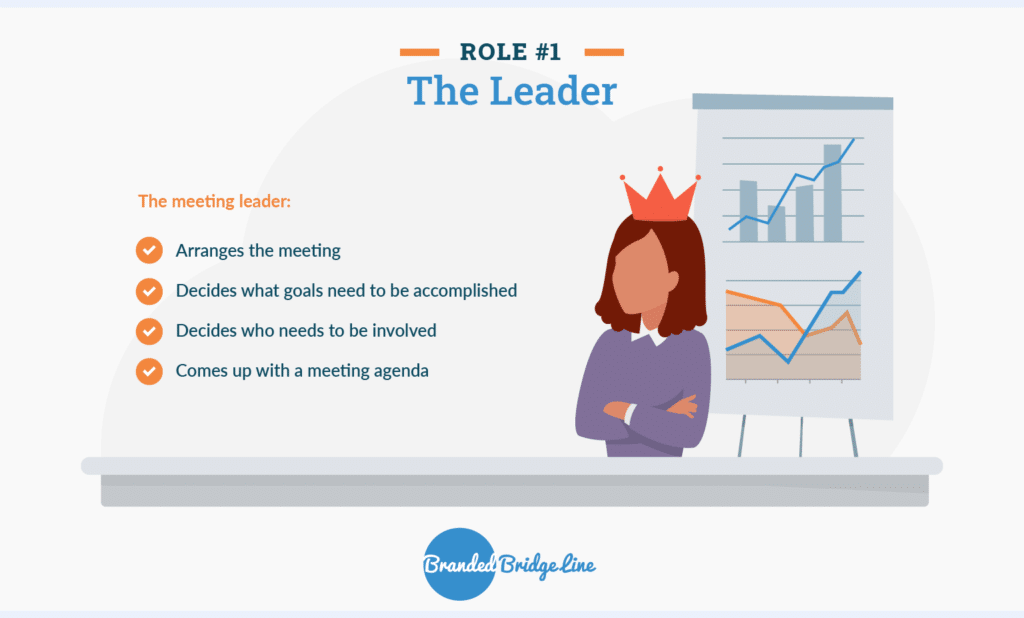
If you’re reading this, odds are this first meeting role has your name written all over it. Leadership is important in all facets of business, and a meeting is no exception.
The meeting leader:
- Arranges the meeting and decides what goals need to be accomplished.
- Decides who needs to be involved (i.e. who they want to hear from). You want enough people there to provide a variety of perspectives but not so many that you can’t come to any conclusions:
- As Michael Mankins told the Wall Street Journal, remember the rule of seven: With each additional meeting participant you invite over seven, the probability you’ll come to an actionable decision goes down 10%!
- Comes up with a meeting agenda for the meeting to keep things on track (if necessary, the leader can delegate this responsibility to role #2).
Meeting Role #2: The Facilitator
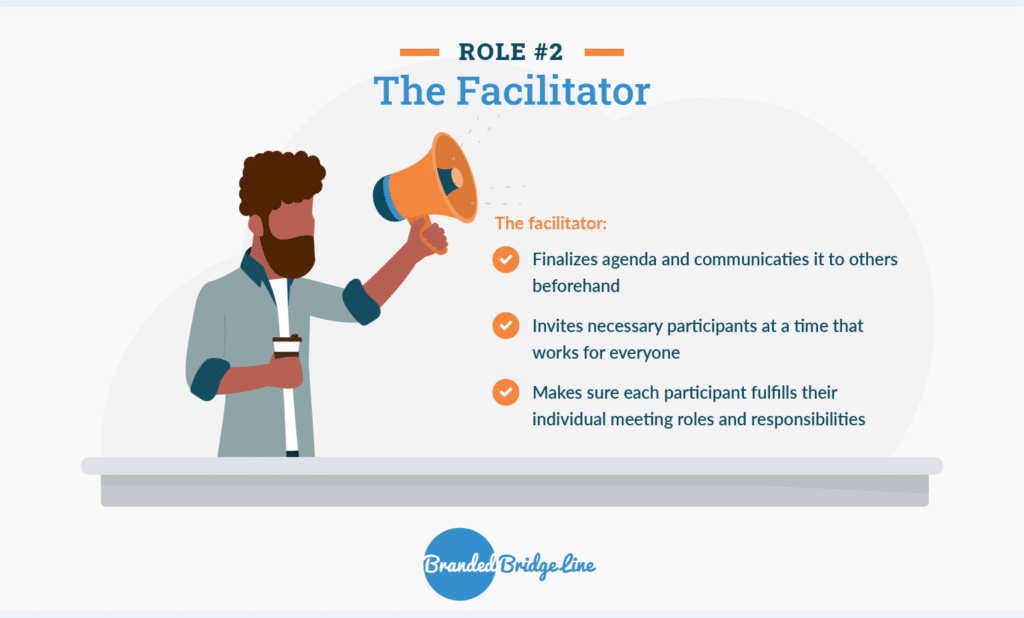
The facilitator is vital when the leader wishes to take full part in the discussion and therefore can’t be focused on keeping everything running smoothly. Facilitators make sure all meeting participants have the resources they need to prepare for and participate in the discussion.
The facilitator is responsible for:
- Finalizing the agenda beforehand and communicating it to the others. Preparation is a vital part of meetings, especially when important decisions need to be made.
- Inviting the necessary participants and finding a time that works for everyone.
- Making sure the meeting stays on track. This includes ensuring each person fulfills their individual meeting roles and responsibilities and guiding the discussion when necessary.
Ideally, the facilitator doesn’t need to input much into the discussion or the content of the meeting, allowing the leader and the other meeting participants to generate the ideas. The facilitator is just there to maximize efficiency.
There are a few features to look for in an audio bridge service that can make the facilitator’s job organizing a conference call much easier:
- PIN-less calling. Remembering a long string of numbers to get into a virtual meeting is a hassle and can cause delays and confusion. Forget the PIN! Simply dial in and go.
- Screen sharing. One of the biggest problems with virtual meetings is the lack of visual aids. Not anymore. Whether you’re giving a presentation, or you just want to keep your action items visible, screen sharing is essential.
Meeting Role #3: The Scribe
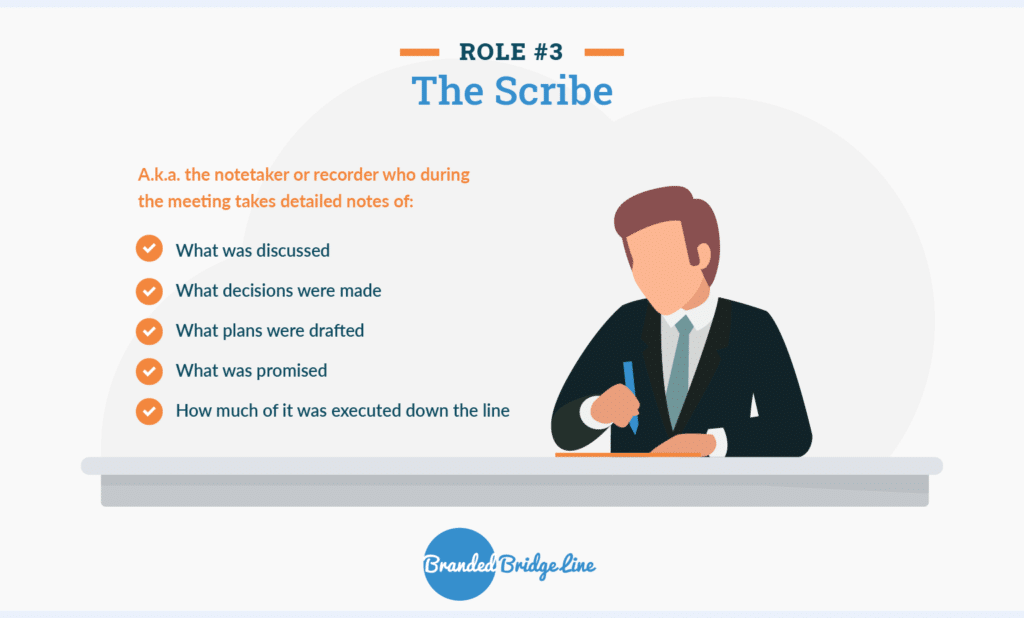
Imagine your meeting is going great; everyone is contributing insightful ideas, decisions are being made, and achievable goals are getting set. When the meeting finally draws to a close, you and all the meeting participants feel like you made significant progress.
But suddenly, you realize you can’t remember half of what was discussed. Unfortunately, no one else remembers either. It’s too late now – all you can do is ensure it never happens again.
Enter: the scribe (a.k.a. the notetaker or recorder). We can’t overstate the importance of this meeting role. Having someone take detailed notes ensures all your great ideas will be remembered long after the meeting ends.
Having a scribe is a great way to hold meeting participants accountable, too. With a clear account of what was discussed, what decisions were made, and what plans were drafted, you’ll know exactly what was promised and how much of it was executed down the line.
While a good notetaker is an important role in any meeting, there’s another failsafe way to ensure you never lose important meeting details: Unlimited call recording and audio storage, a service Branded Bridge Line provides for free with a subscription.
Meeting Role #4: The Peacekeeper
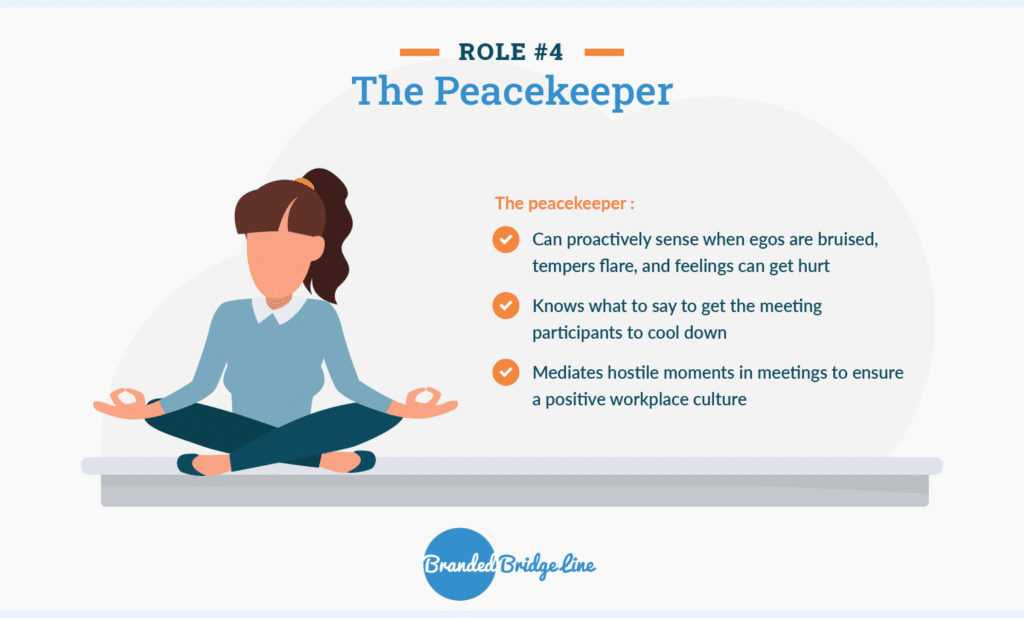
Sometimes passions run hot among meeting participants. Egos are bruised, tempers flare, and feelings can get hurt. When unchecked, this can lead to a toxic and hostile work environment. The fallout from a bad meeting can last a long time.
That’s why every meeting needs a peacekeeper who can mediate these kinds of situations.
Preferably, this meeting role is assigned to someone that demonstrates good emotional intelligence and stays calm but isn’t afraid of confrontation either. This person can sense when things are veering into dangerous territory and knows what to say to get the meeting participants to cool down.
You won’t always need a peacekeeper, but if a meeting goes south, you’ll definitely be better off with one. Plus, fostering collaboration and communication as well as nurturing an inclusive work environment is all part of creating a positive workplace culture. As Dr. Pragya Agarwal writes for Forbes, a good work culture:
- Improves teamwork.
- Increases morale.
- Enhances productivity and efficiency.
- Decreases workforce turnover.
Meeting Role #5: The Outsider
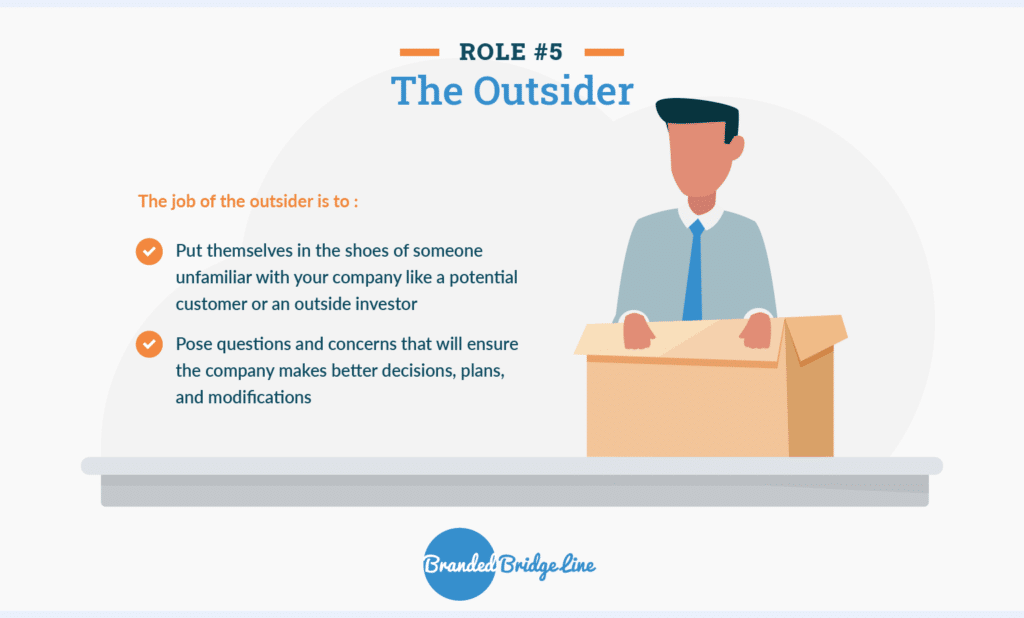
This meeting role sounds mysterious but don’t be frightened – they’re only there to help.
When you’re in a business meeting discussing strategies and ideas with people you work with every day, it’s easy to become isolated in the bubble you’ve constructed around yourselves. That’s why it helps to have someone take on the perspective of an outsider.
The job of the outsider is to put themselves in the shoes of someone unfamiliar with your company. Maybe it’s a potential customer or an outside investor you’re trying to impress. The point is, without an outsider posing questions and concerns, you risk making irrelevant decisions, plans, and modifications.
This meeting role is especially important when discussing strategy that affects the customer-facing side of your business. Think about it: you may have the best product in the world but without being able to reach and appeal to your target consumer, your competitors will swoop in before you know it.
Put These Meeting Roles and Responsibilities into Action!
Now that you’re an expert on meeting roles and responsibilities, try assigning a few at your next meeting. As you organize more meetings, you’ll come up with your own tweaks to these roles and maybe even come up with some new ones.
But wait! There’s one last “role” to keep in mind when you organizing your meetings: a reliable and secure audio-conferencing service.
With more and more meetings occurring remotely these days, the importance of a trustworthy audio bridge that meets your needs can’t be overstated; Branded Bridge Line is an excellent solution that provides a number of excellent features, including toll-free calling to make your conference calls cost-effective and efficient.

Get a single, dedicated conference line and unique phone number for all your business meetings. Less complicated. More professional.



